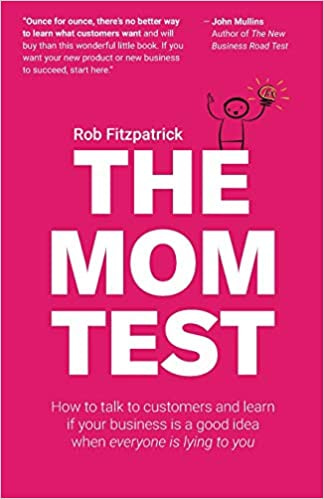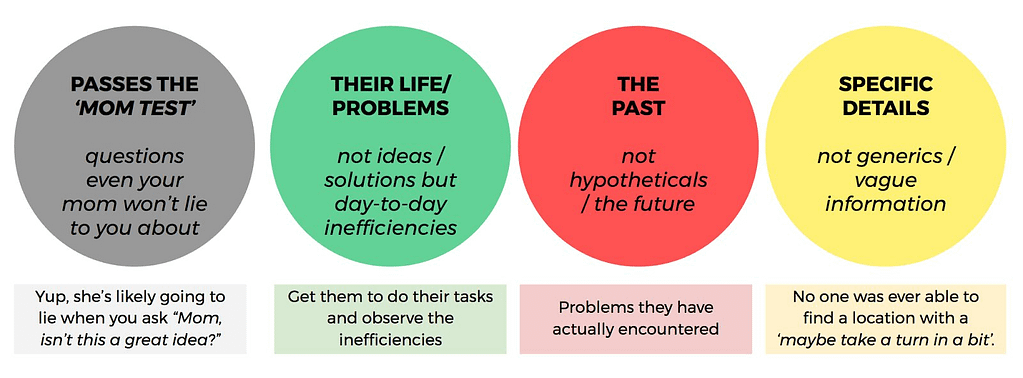
Consider that you have a business idea that you think could potentially be the next big thing; how will you verify if the project is worth giving a shot? Generally, you will discuss the idea and seek feedback from your family, friends, potential investors or even a customer focus group to have the reassurance and some validity that it may work. But, unfortunately, 90% of the start-ups or products fail during their first year or two to 3 years from existence.
You may often notice that family and friends will disguise their actual views with encouraging words as they might not want to hurt you. It is also not uncommon to share your ideas with a potential VC who compliments your proposal but stop returning your calls after the pitch meeting.
The Mom Test by Robert Fitzpatrick is a book that shares how to have better conversations that could result in meaningful insights and ultimately leading to actionable next steps. The Mom Test would lay down a framework for you to better judge if the interactions you are having or had been meaningful or were like the discussions you have with your mom, who continually demonstrate support for everything you plan to do. Here are the three insights I could take away after reading the book:
#1 Don’t pitch; talk about their lives
“It’s not anyone else’s responsibility to show us the truth. It’s our responsibility to find it.”
The Mom Test
A test procedure is considered efficient in healthcare technology by the percentage of false positives expected from it—the lower the number of false positives from the test results, the better the test. The author quotes a conversation between a son and his mother. The latter discusses his idea of having an iPad app for a cookbook that could adequately replace hardback cookbooks.
Scenario 1
The son pitches his idea of having a cookbook that charges $40 as a subscription fee to access multiple cookbooks within the app in the first scenario. The mom starts by saying, aren’t iOS apps costing around $1 and then deflects it with a compliment that the app could be beneficial as she could also share recipes with her friends.
Scenario 2
The son asks his mom if she likes using the iPad and primarily uses activities. He continues by asking if she uses any particular apps to perform actions. She answers by saying that she generally Googles it, suggesting some ideas or an app that could help me execute something she intends to. Son continues the discussion by asking how his mom uses the cookbooks and how often she use them. The son finds out that his mom gets cookbooks as gifts, and she seldom uses some niche cookbooks for specific recipes.
Does scenario one look familiar to you? Most of the time, we go for the big moment of sharing our idea straightaway with a bias that people would buy in. For example, in the first conversation, the son never tried to find if finding a recipe or cookbook is even a problem for his mom or not, if it is a problem, how big it is and what work-around she has to mitigate it in her life. As a result, we only get from such conversations many false positives, which could be the primary reason for your start-up or product failure.
However, in scenario two, the son never uncovered his idea but tried to understand if the problem existed. He tries to find hard facts and meaningful insights about his potential customer’s life and views. For example, he finds that having niche cookbooks in the initial launch would gain better traction than generic cookbooks. Also, he shall need to make an effort on digital marketing and SEO to discover his app on Google. A gifting option in the app may be a good add-on as cookbooks are standard items for gifting.
The Mom Test

- Talk about their life instead of your idea
- Ask about specifics in their past instead of generics or opinions about the future
- Talk less and listen more
The author has called it The Mom Test because it leads to questions that even your mom can’t lie.
#2 Filters to take out the bad data
It is seldom possible that customers have shared a lot of information, including answers to many of your questions, but here are a few filters that one can use to segregate good data and the bad data that could be nothing but fluff:
a. Deflect compliments
When you sit down with somebody, especially in a professional setup, it is often expected that people will not be insulting each other. Instead, you may hear words like “That’s cool, love it” when you share your idea about that world-changing app. This is where you need to realize that you are pitching and thus, deflect by asking questions related to their workflow rather than sharing the solution you are proposing.
b. Fish for commitment
You may hear words like “I would definitely buy that!”, “I could see myself using that!” and it often makes you believe that the meeting went well and the stakeholders liked your idea only to find out that you are not able to get another meeting with the potential investors. You need to look for actionable items out of the sessions and not the fluffy appreciation. Always try to close an encounter with possible next steps, which could be a prototype or another meeting with the next level of decision-makers.
c. Be tactical about ideas
The author shares an example where one of their clients requested an analytics dashboard which the team built, taking six months worth of effort. Post-deployment, the author’s team got to know that the actual problem for the customer was to print an excel sheet that needed to be shared with their customers at a particular frequency. Perhaps, an automated script to send automated email reports to customers could have sufficed with an effort of a week or two.
Similarly, you may hear a plethora of ideas from your customers during such conversations. But, again, you need to be tactical about it and dig deeper with them to know which stage of the workflow would such an idea/feature help them do their work better.
#3 How to have good meetings
The first stage to even have a good meeting with someone is to understand and empathize with their problems. Then, having a precise segmentation of your customer base will increase your chances of a positive outcome and help you learn something meaningful about your potential users.
The author suggests having as many informal meetups as possible rather than having a formal meeting by blocking calendars. Immerse yourself in their spaces, such as meetups, knowledge sharing sessions/webinars, or industrial blogging. The top booster to you having positive meetings could be when you get warm intros using your network.


